
Cusp of Quantum Computer Age
- Tohoku University: Quantum Annealing Research & Development -
Category: ICT
Published: 2018
#1803a
Masayuki Ohzeki (大関真之)
18329u
Title
Cusp of Quantum Computer Age
量子コンピュータ時代の幕開け
Index
Tag
; Approximate computing; ; Cbit; Combinational optimization problem; Digital annealor; D-Wave; End of Moore's law; Explosion of data; Grover algorithm; Machine learning; MPP; Proof of concept; Qbit or Qubit; Quantum annealing; ; Shor algorithm; Tunneling effect;
Why
- Very impressive presentation of the theme was given at the Glocom Roppongi Forum on 2018/Mar./26 at the Internationa House of Japan. Here is the summary of it.
Résumé
Remarks
>Top 0. Introduction:
- The year 2017 was an epoch making year; which is called as the first or cusp year of quantum computer. In 2017/Nov./10, IBM announced the success of quantum tip of 50 qubit (actually 49 qubits), which is considered as the limit of supercomputer. In 2018/Jan/10 Intel also announced their 49 qubits. In 2018/Mar/5 Google announced Bristlecone 72 qubits.
- Drastic change is about to happen by rapid development of AI. Quantum computer is useful in a certain area of development of AI, being expected to create new field.
- Present computer (which will be soon called classic computer) handles the information by binary bit (0 or 1, or head or tail which is called classic bit or Cbit), but quantum computer by quantum bit (two state or quantum state system called qubit, or Qbit), which retains the superposition and phase difference.; which means the calculation of 1001 or 0110 is recognized as the similar one.
- Quantum computer would be a decisive solution, being expected to break through the limit of Moor's law.; because wiring of 4nm is approaching almost limit.
0. 序文:
- qubit, Qbit
- classic computer; Cbit

>Top 1. Application of Quantum Computer?:
- Quantum Computer is not very fast in its calculation itself. Because its operating (including cooling) resource or power depends on conventional power of electricity or optics; which is the same level of that of the present supercomputer at most.
- But It has a narrow, but better field of calculation (such as machine learning, protein folding, route planning, to name a few): it is possible to take advantage of features of qubit, if proper algorithm is prepared. Consequently, quantum computer could outperform the most powerful supercomputer in calculating certain types of problems.
- Three features of quantum computer:
- >Top Massively parallel processing (MPP): Principle of superposition.
- Conventional tip (Cbit) is 0 or 1 (or on and off), but qubits can handle 0 and 1 situation concurrently, which is effective in probability mathematical problem.
- 50 qubits translates into 10 peta (1016) numbers.
- Use of interference:
- to refine or narrowing down of possibilities in very effective ways.
- Handling of fluctuating observation:
- to get probable result by using particular and dextrous algorithm.
- >Top Certain applications:
- Prime factorization: Shor algorithm (discovered in 1994)
- Fast database search: Grover algorithm
- Optimization problem: Quantum annealing (QA)
1. 量子コンピュータの応用:
- massively parallel processing: 超並列性
- principle of superposition: 重ね合わせの原理
- annealing: a metallugical process 焼きなまし
- cryogenic: very low temperature
- proof of concept: 概念実証
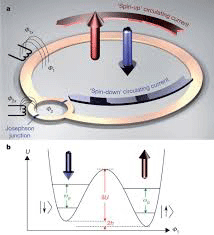
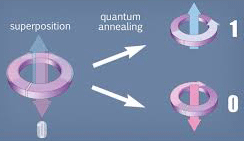
>Top 2. D-Wave Systems, Inc.:
- D-Wave Systems, Inc.: Quantum computing company of Canada; the first commercial quantum computer;
- Established: 1999
- Office: BC, Canada
- Representative: Vern Brownell, CEO
- Staff: about 70
- the latest D-wave 2000Q (>Fig.)
- 128 qubit computer is $10M
- It is not a universal quantum computer, and cannot execute Shor algorithm; only claims only to do quantum annealing.
- can operate at cryogenic temperature
- consuming very low electricity: for operation (including cooling) 15kW, and overwhelmingly small for processing 2fW (femto: 10−12$
- operating temperature: -273ºC (Cf. Intel 64: 67.9ºC)
- magnetic shielding: 3☓3☓3m
- Users: Lockheed Martin; NASA; Google (NASA and Google established QuAIL (Quantum Artificial Intelligence Lab).
- >Top What is quantum annealing?: (>Fig.)
- A current state is randomly replaced by a randomly selected neighbor state if the latter has a lower energy. The process is controlled by the tunneling field strength.
- The tunneling field starts high, so that the neighborhood extends over the whole search space; and is slowly reduced through the computation, until the neighborhood shrinks to those few states that differ minimally from the current states.
- By that time, the system finds a very deep (hopefully, the global one) minimum and settles there.
- >Top Combinational optimization problem:
by finding low-energy configurations by exploiting tunneling effects to escape local minima. (>Fig.)
- Ramsey numbers: How many people do you need to invite to a party that a subset of them will know each other (denoted m), and another subset (denoted n) will no know each other.
- R(3, 3) and R(m, 2) for 4≤m≤8
- Comparison of performance:
- Simulated Annealing (SA), Quantum Monte Carlo (QMC), and D-Ware 2X.
- Shown are 50, 75, 85 percentiles over a set of 100 instances.
- >Top Proof-of-Concept: D-Wave is roughly 100M times faster than conventional core processor, but only for specific problem.
- NASA hopes quantum computers could help schedule rocket launches and simulate future missions. It is a truly disruptive technology.
- Google's researchers explore quantum annealing advantages; Dec. 2015. (>Fig.)
2. カナダD-Wave社
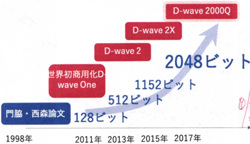

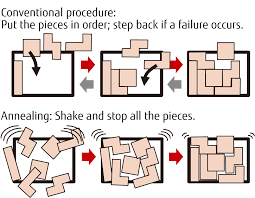
-
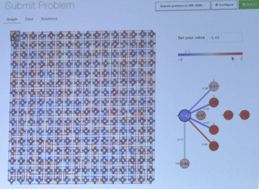

>Top 3. Development Situation in Japan:
- Machine Learning: Collaboration of DENSO and Tohoku Unit.:
- Optimization problem using quantum annealing:
has outperformed Adam (Adaptive Momentum Estimation) in case of 1) Handwriting recognition of MNIST (Mixed National Institute of Standards and Technology database), and 2) Face recognition of Olivetti dataset:
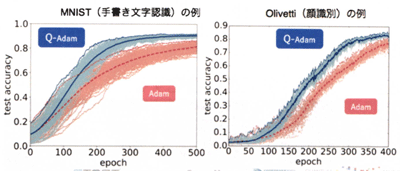
- >Top New computing architecture (by Fujitsu): (>Fig.)
- Approach to various optimization problems:
- Natural disaster measures, Security, Digital marketing, Finance, Transportation & logistics, Medical, Chemical & Pharmacy, Energy, etc.
- Features of Digital annealor:
- Mapping of the problem by total connection architecture
- Rapid searching by parallel searching
- Escape from local minimum (giving offset to the energy level)
3. 日本の開発状況:
- approximate computing: approximate result is sufficient for a purpose

- Two methods of quantum annealing:
- 1) Superconducting circuits: developed since 1980s.
- 2) Quantum annealing: Developed by Hidetoshi Nishimori (西森秀稔; Tokyo Inst. Tech) in 1998.
- New computing architecture:
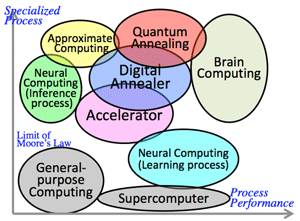
>Top 4. Reference:
- Explosion of data:
- Quantity of digital data is exploding, which requires more processing power of computer. (>Fig.)
- 40 ZB by 2020, and 1 YB by 2030;
- 1PB=1015;1EB=1018;1ZB=1021;1YB=1024
- peta=103・5;exa=103・6<hexa;
zetta=103・7<zepto<septi;
yotta=103・8<yocto<octo
- Non-structural data produced by IoT or sensors are increasing than conventional structural data of conventional ICT systems.
- >Top End of Moore's Law:
- The Moore's Law (doubling its integration in every 18 months) is now approaching its limit in each field of:
- number of cores, consumption of electricity, frequency of CPU, and number of transistors.
- Computing Paradigm Shift:
- Domain orientated computing is an extension of the general purpose computing; but in the future, quantum computer and neurocomputer as the new computing paradigm are needed:
- Various technology of quantum computer:
- Idding machine method:
- Quantum gate method:
参考:
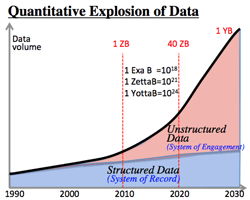
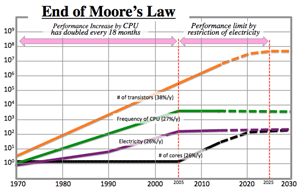
>Top 4. Reference:
- Qubit image:

 |
Cusp of Quantum Computer Age- Tohoku University: Quantum Annealing Research & Development -
|
Category: ICT |
Masayuki Ohzeki (大関真之) |
18329u |
Title |
Cusp of Quantum Computer Age |
量子コンピュータ時代の幕開け |
|---|---|---|
Index |
||
Tag |
; Approximate computing; ; Cbit; Combinational optimization problem; Digital annealor; D-Wave; End of Moore's law; Explosion of data; Grover algorithm; Machine learning; MPP; Proof of concept; Qbit or Qubit; Quantum annealing; ; Shor algorithm; Tunneling effect; | |
Why |
|
|
Résumé |
Remarks |
|
>Top 0. Introduction:
|
0. 序文:
|
>Top 1. Application of Quantum Computer?:
|
1. 量子コンピュータの応用:
|
>Top 2. D-Wave Systems, Inc.:
|
2. カナダD-Wave社
|
>Top 3. Development Situation in Japan:
|
3. 日本の開発状況:
|
>Top 4. Reference:
|
参考: |
>Top 4. Reference:
|
|